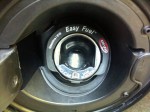It occurred to me that some of my friends don’t really know how to taste and describe beer properly. Even my wine friends, descriptive as they are, are pretty poor at describing beer. The methods of tasting are not all that different, really. There’s more of a snobbery surrounding wine and some of people are loathe to come down to the beer world, even though we beer snobs are far bigger jerks. 😀
But I figured that I’d try and educate some people on the proper way anyway. What the heck, eh?
There’s four steps to tasting a beer. To make it fun, let’s make them all start with the letter S. 🙂
1. See.
When a beer is poured it produces a foamy head. This head usually dissipates quickly, leaving behind a bit on top called the “lace”. This same lace remains on the sides of the glass when drinking the beer. Hold up the beer and take note of the color as well. These are all descriptive aspects that help in understanding of the beer.
- Color describes the malts used, or the brewing process.
- The amount of foam describes the carbonation.
- How it dissipates describes the thickness or heavyness of the beer.
- The amount of lace describes the freshness of the beer, the freshness of the hops used.
2. Swirl.
Yes, damnit, swirl it a bit, like you would a wine. This agitation pulls out the scents and carbonations from the brew. It also tests the head retention, which gives you more info about the lacing.
3. Smell.
Smell the beer, obviously. Something like 80-90% of taste is actually smell. It’s the most important part of tasting. Breath deeply of the beer through your nose and then, yes, through your mouth as well. The combination of these two gives you the best experience of the brew. Describe the scents you have. Wheat beers, for example, are often fruity or citrusy, usually because the brewer adds these types of ingredients specifically. Hops have a distinct odor, of course, but different types of hops smell different. Cascade hops (the most common type) smells completely different from fuggle hops, for example, and they are used in completely different types of beers.
4. Sip.
Take a sip, swirl it around your mouth a bit. Don’t swallow right away, let it warm up a small amount. Important bits to remember here:
- Mouthfeel. You see this one a lot in beer circles. What does it feel like? What’s the texture of the beer?
- Consistency. Does the beer change a lot as you taste it? From beginning to end of glass even.
- Breathe out while the beer is in your mouth. This increases the flavor experience. Really. Google “retro-olfaction”.
- What does it taste like? Salty? Bitter? Sweet? Acidic? Oily? Fruity? Beer can taste like just about anything, think of what it’s similar to. Describe what it would go with.
Now, once you’ve done this, describe the beer. Here’s an example for PBR:
Clear golden color, with a 3/4 inch thick white head, which quickly reduced to a minimal thin lacing. Pleasant but subdued scent, mostly sweet lagered malts. Slight amount of grain flavors, with subdued grassy hop undertones. Minimal bitterness. Somewhat fizzy in apperance, but only lightly carbonated flavors. Crisp and dry mouthfeel, with a slight hint of oilyness when warmer. Overall clean flavor, very light malts used. Good session beer, would be excellent with stronger beef or spiced chicken flavors.
Simple.















